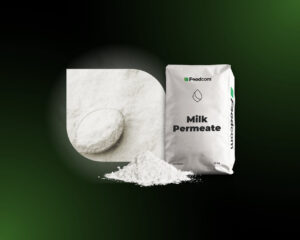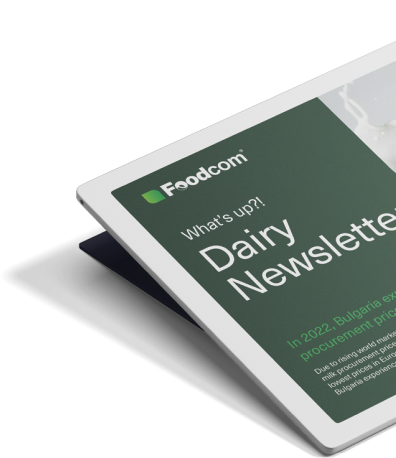- The prices of dairy fats and cheeses are rising, with cream reaching record levels, indicating a clear tightening of the market.
- Milk powder is stable, but the limited availability of milk does not allow for an increase in production.
- Europe continues to struggle with low milk supply, while Poland is one of the few EU countries to increase production and outperform EU average prices.
- New Zealand may enter the Indian market, which could strongly influence global dairy trade – an opportunity, but also a threat to local producers.
Welcome Partners!
Welcome back to our newsletter!
Let’s take a look at what has been happening in the dairy market recently!
Milk powder
Spot prices for food-grade skimmed milk powder (SMP) in Europe remain stable at 2350-2450 EUR/MT, depending on freshness and product origin. Export demand remains cautious and competitive pressure from regions outside the EU persists. Polish SMP prices remain stable at around 2450 EUR/MT.
Skimmed milk powder offers for feed have softened slightly, with Q2 and Q3 deliveries on the Dutch market (DAP NL) now bid at around 2400 EUR/MT, compared to previous levels.
European whole milk powder prices have strengthened, currently quoted at 4350-4400 EUR/MT, supported by a strong fat market and slightly higher processing costs. Milk availability, although seasonally increasing, remains insufficient to drive significant production growth.
Cheese
Gouda cheese prices continue their upward trajectory, currently at 4450-4500 EUR/MT. Lower stocks, reduced milk consumption in France, Germany and the Netherlands and high butter prices are contributing to stronger offers for Q2. Producers are maintaining a cautious approach to selling, while buyers are split between forward buying and waiting for potential spring corrections.
Edam 40% cheese prices also increased slightly to 4400-4450 EUR/MT, supported by limited supply and continued demand in Western Europe.
Mozzarella is quoted at 4350-4450 EUR/MT, with prices up as a result of strong seasonal demand and limited availability of April volumes. Despite increasing milk flows, spot prices remain strong, reflecting the current imbalance in supply and demand.
Emmental remains stable at 4700-4800 EUR/MT. Production continues to lag behind last year’s levels, particularly in France, supporting stable prices. Limited stocks among producers are keeping the market tight.
European cheddar prices are quoted at 4850-4900 EUR/MT, slightly stronger compared to earlier this month. While Irish supply remains limited, export markets’ interest in alternative sources is growing, especially in the face of widening price differentials with the US.
Fats
Butter remains stable in Europe, currently trading in the 7350-7450 EUR/MT range, with spot values reaching as high as 7530 EUR/MT. Demand remains consistent in DE/NL/BE, although availability is gradually improving. Polish butter trade levels have remained stable. Volumes coming from Ukraine are starting to enter the market, potentially easing local constraints.
Anhydrous milk fat continues to follow the upward trend of the fat complex, with prices above 9000 EUR/MT, supported by international demand and low cream supply.
Liquids
Cream prices remain high across Europe. In southern Germany, spot transactions were recorded at 9000 EUR/MT at the beginning of the week, while the northern regions show values around 8600 EUR/MT. Limited raw milk availability continues to drive stable prices across the region. Polish cream is priced at around 9000-9200 EUR/MT.
Spot milk prices across Europe have fallen slightly but remain high. Current indications range from 49.00 to 54.00 EUR/100 kg, depending on region and fat/protein content. While milk production is slowly increasing, several EU countries still lag behind seasonal averages. Additional concerns arise from renewed outbreaks of the bluetongue virus, which may affect milk collection in some areas, particularly in Hungary and Slovakia.
Concentrated skimmed milk (SMC) prices softened, with the German-origin product quoted at 2000-2100 EUR/MT FCA DE. Lower demand and resumed operations at powder factories are affecting values.
Whey powder
Food grade SWP is stable at 1080-1120 EUR/MT, supported by limited whey availability and strong WPC production. Weakness in the US market has not yet translated into downward pressure in Europe.
SWP feed is quoted at 930-950 EUR/MT and offers for Q2 are stable in the Dutch market. At the beginning of the week, sweet whey concentrate prices fluctuated between 400-500 EUR/MT FCA, but recent offers have reached 700 EUR/MT, reflecting increased demand and decreasing supply.
WPC80 Instant prices remain high at 11600-11800 EUR/MT, driven by continued global interest and limited availability. With most volumes for Q2 already contracted, buyers are struggling to secure spot supply.
WPI prices in Europe remain stable at 23000-23500 EUR/MT. Demand continues to outstrip supply, and even with increasing production in the US, there remains a shortage in the European market. A broad premium remains over US products, mainly due to strong domestic and regional demand in the EU.
News
Asia
New Zealand has launched a public consultation on a planned free trade agreement with India, which could prove groundbreaking for the country’s export sector – particularly dairy. The Wellington government is aiming to double the value of exports in the coming decade, and opening up to the Indian market of 1.4 billion consumers is expected to play an important role in this. Feedback from citizens, businesses and organisations can be submitted until 15 April.
While the deal could create huge opportunities for New Zealand producers, it also raises concerns among Indian farmers. An influx of competitively priced dairy products could threaten local incomes and the stability of the sector. Experts stress that it will be critical to come up with a balanced agreement that takes into account the interests of both sides – both trade development and food security in India.
Europe
During the dairy debate in Warsaw, Dr Waldemar Guba from the Ministry of Agriculture and Rural Development pointed out that, according to European Commission forecasts, only new EU countries such as Poland will increase milk production in the coming years. In the ‘old 14’, a decline is predicted, mainly due to exhausted reserves of productivity growth.
Poland, which accounts for as much as half of milk production in the group of new Member States, is already starting to achieve higher average purchase prices than the EU average. This is evidence of the sector’s efficiency, growing demand and high processing potential – factors that could strengthen Poland’s position as the region’s dairy leader.
Oceania
Fonterra predicts a second consecutive season with a high milk price – even above NZD10/kgMS. Despite solid financial results and growing demand for dairy products, the cooperative warns farmers of the impact of global tensions, including tariffs and the geopolitical situation.
DairyNZ’s forecast is for a payout of NZD10.13/kgMS in 2025/26, which would be a historic exception after years of declines following strong seasons. At the same time, Fonterra is reporting a 2.7% increase in milk procurement and stresses that it is targeting the highest possible but stable procurement price. Optimism is there, but caution remains paramount.
![The dairy market is becoming increasingly tense – are Your prices still competitive? [261st Edition of the DAIRY Newsletter] The dairy market is becoming increasingly tense – are Your prices still competitive? [261st Edition of the DAIRY Newsletter]](https://foodcom.pl/wp-content/uploads/2023/08/Newsletter_Dairy-1520x760.jpg)






